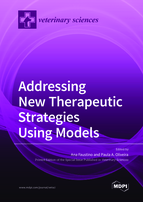Addressing New Therapeutic Strategies Using Models
A special issue of Veterinary Sciences (ISSN 2306-7381).
Deadline for manuscript submissions: closed (15 December 2021) | Viewed by 50414
Special Issue Editors
2. Centre for the Research and Technology of Agro-Environmental and Biological Sciences (CITAB), Vila Real, Portugal
Interests: veterinary medicine; experimental animal models; anti-inflammatory drugs; physical exercise; tumor angiogenesis; lymphangiogenesis
Special Issues, Collections and Topics in MDPI journals
Interests: animal models, in vivo studies, natural compounds,
Special Issues, Collections and Topics in MDPI journals
Special Issue Information
Dear Colleagues,
A disease model displays pathological processes observed in human or animal diseases. The models are fundamental tools in biomedical research, and they are invaluable for providing new insights into mechanisms underlying organ function, to establish the pathophysiology of a disease, and to test potential therapeutic approaches.
Models have been long used to study several diseases, including cardiovascular, oncologic, metabolic, infectious, and neurological diseases, among others. Animals or cells displaying pathological processes observed in human or animal diseases have been used as models. Moreover, mathematical models are also of great importance to disease modeling. Animal models offer the unique opportunity to investigate the function of genes and pathways and the in vivo effects of drugs, bridging the gap between basic science and the treatment of diseases. The selection of a suitable model system is a crucial step in research design. For disease modeling to be meaningful, a relevant cellular or genetic phenotype must be observed. Without the use of models, both research and clinical practice worldwide would be vastly different today.
This Special Issue aims to publish original research works or reviews with models of disease, highlighting their importance to search for new therapeutic strategies.
Dr. Ana Faustino
Dr. Paula A. Oliveira
Guest Editors
Manuscript Submission Information
Manuscripts should be submitted online at www.mdpi.com by registering and logging in to this website. Once you are registered, click here to go to the submission form. Manuscripts can be submitted until the deadline. All submissions that pass pre-check are peer-reviewed. Accepted papers will be published continuously in the journal (as soon as accepted) and will be listed together on the special issue website. Research articles, review articles as well as short communications are invited. For planned papers, a title and short abstract (about 100 words) can be sent to the Editorial Office for announcement on this website.
Submitted manuscripts should not have been published previously, nor be under consideration for publication elsewhere (except conference proceedings papers). All manuscripts are thoroughly refereed through a single-blind peer-review process. A guide for authors and other relevant information for submission of manuscripts is available on the Instructions for Authors page. Veterinary Sciences is an international peer-reviewed open access monthly journal published by MDPI.
Please visit the Instructions for Authors page before submitting a manuscript. The Article Processing Charge (APC) for publication in this open access journal is 2600 CHF (Swiss Francs). Submitted papers should be well formatted and use good English. Authors may use MDPI's English editing service prior to publication or during author revisions.
Keywords
- in vitro
- in vivo
- mathematical
- modeling
- treatment








